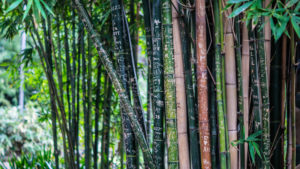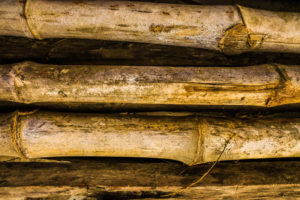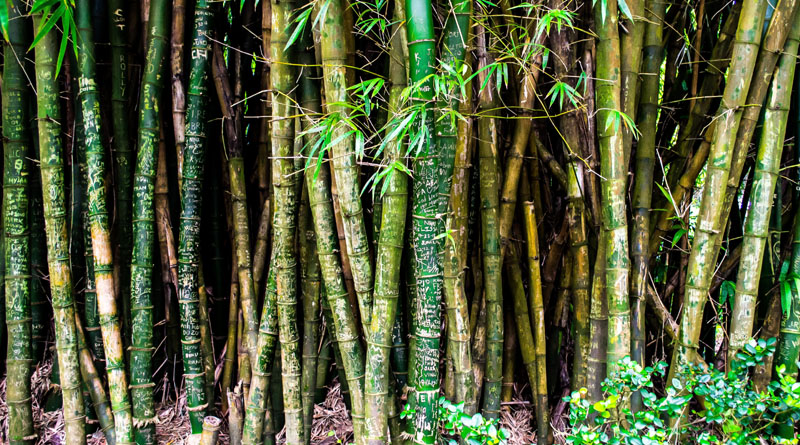IS BAMBOO ECO-FRIENDLY?
Bamboo’s uniquely fast growth, moisture wicking fibres, and ease of cultivation have made it a popular cellulose source for fabric manufacturers, but is it really as eco-friendly as many claim or is there a fair amount of green-washing taking place by those who hope to sell us bamboo as a ‘green’ alternative to cotton and made-made fabrics?
Cultivation
China and India are the world’s largest producers of bamboo, followed by Myanmar and Thailand. Bamboo is often generically “greenwashed” as a sustainable crop due to its;
 Dense growth patterns (efficient use of space)
Dense growth patterns (efficient use of space)
Complex root structure (prevents erosion and maintains soil health)
Very high respiration rates (significant carbon dioxide absorption and oxygen production)
Water efficiency (doesn’t require irrigation)
Hardiness (doesn’t require pesticides or insecticides)
Although these features lend themselves to environmental causes, case-specific factors such as land clearing, harvesting practices, labour conditions, and supplementary irrigation or pesticides (which are not necessary for bamboo growth, but are performance enhancing) must be factored in when determining sustainability.
Processing
Mechanical processing yields the most environmentally friendly bamboo fabric. The woody grass shoots and leaves are pulverised and then retted (soaked in water) to soften. Next, the fibrous pulp is combed, refined, and spun into yarn. The result is a bamboo ‘linen’, or ‘natural’ bamboo fabric which is suitable for dyeing and does not require intensive pre-treatment. Due to the time and labour intensity of the mechanical processing, natural bamboo fabric is relatively expensive and difficult to source.
Chemical processing is used to produce the vast majority of bamboo fabrics. Within this category, conventional viscose processing is the most common method, and is also the most detrimental to human health and the environment. While chemical processing is the cheaper method of processing bamboo fibres, it is far less sustainable. The chemicals used to process the fibres include sodium hydroxide and carbon disulfide, which are potentially harmful to the people working with it and the wildlife in the area, especially if the chemicals reach any water sources.
Fibre Mixtures
Viscose Bamboo Rayon
This process requires considerable energy and chemical input. Bamboo is first crushed, then soaked in a sodium hydroxide solution, pressed, dried and crushed again. Carbon disulfide is added to create a gel, which is again treated with sodium hydroxide, before being pressed through narrow nozzles into sulfuric acid to create threads, where it hardens and is finally spun and woven. The end fabric is soft, drapes similarly to silk, and is well suited to garment manufacturing. However, the material’s functionality often comes with hidden costs such as worker illness from chemical exposure, and negative effects on the environment. One of the most significant environmental effects is wastewater laden with a large variety of chemicals being freely discharged during the manufacturing process.
Lyocell Bamboo Rayon
An alternative rayon fabric with limited environmental impacts, lyocell rayon is produced in a closed-loop viscose process which utilizes a non-toxic solution (amine oxide) and minimizes water and energy consumption. The processing steps are similar to conventional viscose rayon: bamboo is pulped, softened, thickened, and formed into weavable fibre. The end product, however, is notably free of chemical residues, and has not been associated with worker illnesses or environmental damage. Additionally, virtually all of the amine oxide solution is recovered and reused. Lyocell rayon performs at least on par with conventional rayon fabric and is not significantly more expensive to produce.

5 reasons to consider using bamboo
1: Eco-friendly
If using sustainable materials is of interest to you, bamboo fibre should definitely be a material to consider. Bamboo can be grown sustainably without the use of pesticides and fertilizers due its fast growth rate and protective coating, and can be processed sustainably if the mechanical, rather than chemical, processes are chosen.
2: Strength and Flexibility
Bamboo fibres are naturally strong yet very flexible. This is a rare combination to have in clothing or furniture materials and it opens many doors for product designs and uses. When used in furniture bamboo fibres are comfortable to sit on and have the flexibility to bend with a person’s weight.
3: Lightweight
Bamboo is very light and easy to move, which makes it a practical material to use for larger furniture pieces such as tables and benches, enabling people to lift and move their furniture as they please.
4: Practicality & Comfort
Aside from being arguably more comfortable than cotton and polyester fabrics, bamboo fabric has the ability to absorb water and keep the wearer extremely dry; it is highly breathable, odour resistant, and thermally regulating. Bamboo fabric feels silky and luxurious, providing unparalleled comfort. Due to its flexibility, furniture made of bamboo can be very comfortable and less rigid than those made from other materials such as wood.
5: Easy Maintenance
Bamboo fibre is very strong and doesn’t wear badly over time, regardless of how many times it is washed or dried. Its sturdiness also prevents pilling from occurring after washing and drying. Furniture made from bamboo is very smooth due to a natural coating of oil that exists in its fibres, and it can be cleaned easily.
Natural bamboo fabric is one of the most ‘green’ fabrics available – if the right fibres and processing are chosen; mechanically produced bamboo fibres are far more sustainable than those that are chemically produced, and lyocell bamboo rayon, for example, is far more sustainable than viscose bamboo rayon.
Overall, being aware of “greenwashing” when choosing between bamboo fabrics, as well as the significant socio-ecological differences between production processes is important. Not all bamboo fabrics are made in the same way or have the same sustainability benefits.
ABOUT THE AUTHOR

Gus Bartholomew is co-founder of Supplycompass, a tech enabled end-to-end production management platform for responsible brands that want to find and work with the best international manufacturers. It enables brands to find their perfect manufacturing partner at home or overseas. Brands can create tech packs, get matched with a manufacturer and use the platform to manage production from design to delivery. Supplycompass works with brands and manufacturers to embed responsible and sustainable practises in their businesses and deliver value and create opportunities for growth.
 See: http://www.supplycompass.com
See: http://www.supplycompass.com
Instagram: @Supplycompass
Facebook: facebook.com/supplycompass
Twitter: twitter.com/Supplycompass
LinkedIn: https://www.linkedin.com/company/supplycompass/
LinkedIn: https://uk.linkedin.com/in/gusbartholomew

